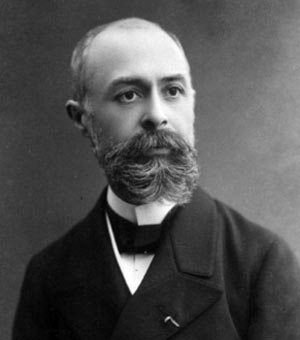Edmond Becquerel: Difference between revisions
No edit summary |
No edit summary |
||
| (19 intermediate revisions by the same user not shown) | |||
| Line 1: | Line 1: | ||
Created By Puri | |||
---- | |||
[[File:LO11DA35798174058001804684.jpg]] | |||
---- | |||
Edmond Becquerel (1820-1891) was a French physicist. He is best known for his work on the key principle to solar energy cells, the photovoltaic effect. | |||
==Early Life and Career == | |||
== | Edmond Becquerel was born in Paris on March 24, 1820, Alexandre. He was first a student, and then an assistant, to his father Antoine César. Edmond was particularly intrigued by light and embarked on in-depth studies of the subject. He examined the spectroscopic characteristics and the photochemical effects of the sun, and was especially interested in the phenomena of fluorescence and phosphorescence. He received his doctorate from the University of Paris, and eventually took a professorial position at the Agronomic Institute of Versailles. | ||
==Research on Photovoltaic Effect== | |||
When Edmund Becquerel was 19 years old (in 1839) he discovered the photovoltaic effect. He discovered this effect while experimenting with an electrolytic cell made up of two metal electrodes. Becquerel found that certain materials would produce small amounts of electric current when exposed to light. Because of this work, the photovoltic effect has also been known as the "Becquerel effect". | |||
== | ==Other Studies== | ||
Edmund Becquerel is also known for his studies in the solar spectrum, magnetism, electricity and optics. In electricity he measured the properties of currents and investigated the conditions under which they arose. He showed that Joule’s law governing the production of heat in the passage of an electrical current applied to liquids as well as to solids. He also studied the separate effects of the liquid, the metal, the temperature, and the polarization of the electrodes on the functioning of voltaic piles. | |||
==Honors and Awards== | |||
Becquerel was elected a member of the Royal Swedish Academy of Sciences in 1886. | |||
The Alexandre Edmond Becquerel Prize was established in 1989 by the European Commission at the occasion of the 150th anniversary of Becquerel’s classical experiment in which he discovered the photovoltaic effect. Its purpose is to honour scientific, technical or managerial merit in the development of photovoltaic solar energy. It is awarded annually at the European Photovoltaic Solar Energy Conference and Exhibition. | |||
== | == See also == | ||
===Further reading=== | ===Further reading=== | ||
https://en.wikipedia.org/wiki/Photovoltaic_effect | |||
===External links=== | ===External links=== | ||
http://www.pveducation.org/pvcdrom/solar-cell-operation/photovoltaic-effect | |||
==References== | ==References== | ||
http://www.solarenergyworld.com/2011/06/17/solar-history-alexandre-edmond-becquerel/ | |||
http://micro.magnet.fsu.edu/optics/timeline/people/becquerel.html | |||
http://encyclobeamia.solarbotics.net/articles/photovoltaic.html | |||
http://www.encyclopedia.com/doc/1G2-2830900329.html | |||
http://www.becquerel-prize.org/cms/about-the-becquerel-prize.html | |||
[[Category:Which Category did you place this in?]] | [[Category:Which Category did you place this in?]] | ||
Latest revision as of 17:04, 5 December 2015
Created By Puri
Edmond Becquerel (1820-1891) was a French physicist. He is best known for his work on the key principle to solar energy cells, the photovoltaic effect.
Early Life and Career
Edmond Becquerel was born in Paris on March 24, 1820, Alexandre. He was first a student, and then an assistant, to his father Antoine César. Edmond was particularly intrigued by light and embarked on in-depth studies of the subject. He examined the spectroscopic characteristics and the photochemical effects of the sun, and was especially interested in the phenomena of fluorescence and phosphorescence. He received his doctorate from the University of Paris, and eventually took a professorial position at the Agronomic Institute of Versailles.
Research on Photovoltaic Effect
When Edmund Becquerel was 19 years old (in 1839) he discovered the photovoltaic effect. He discovered this effect while experimenting with an electrolytic cell made up of two metal electrodes. Becquerel found that certain materials would produce small amounts of electric current when exposed to light. Because of this work, the photovoltic effect has also been known as the "Becquerel effect".
Other Studies
Edmund Becquerel is also known for his studies in the solar spectrum, magnetism, electricity and optics. In electricity he measured the properties of currents and investigated the conditions under which they arose. He showed that Joule’s law governing the production of heat in the passage of an electrical current applied to liquids as well as to solids. He also studied the separate effects of the liquid, the metal, the temperature, and the polarization of the electrodes on the functioning of voltaic piles.
Honors and Awards
Becquerel was elected a member of the Royal Swedish Academy of Sciences in 1886.
The Alexandre Edmond Becquerel Prize was established in 1989 by the European Commission at the occasion of the 150th anniversary of Becquerel’s classical experiment in which he discovered the photovoltaic effect. Its purpose is to honour scientific, technical or managerial merit in the development of photovoltaic solar energy. It is awarded annually at the European Photovoltaic Solar Energy Conference and Exhibition.
See also
Further reading
https://en.wikipedia.org/wiki/Photovoltaic_effect
External links
http://www.pveducation.org/pvcdrom/solar-cell-operation/photovoltaic-effect
References
http://www.solarenergyworld.com/2011/06/17/solar-history-alexandre-edmond-becquerel/
http://micro.magnet.fsu.edu/optics/timeline/people/becquerel.html
http://encyclobeamia.solarbotics.net/articles/photovoltaic.html
http://www.encyclopedia.com/doc/1G2-2830900329.html
http://www.becquerel-prize.org/cms/about-the-becquerel-prize.html
